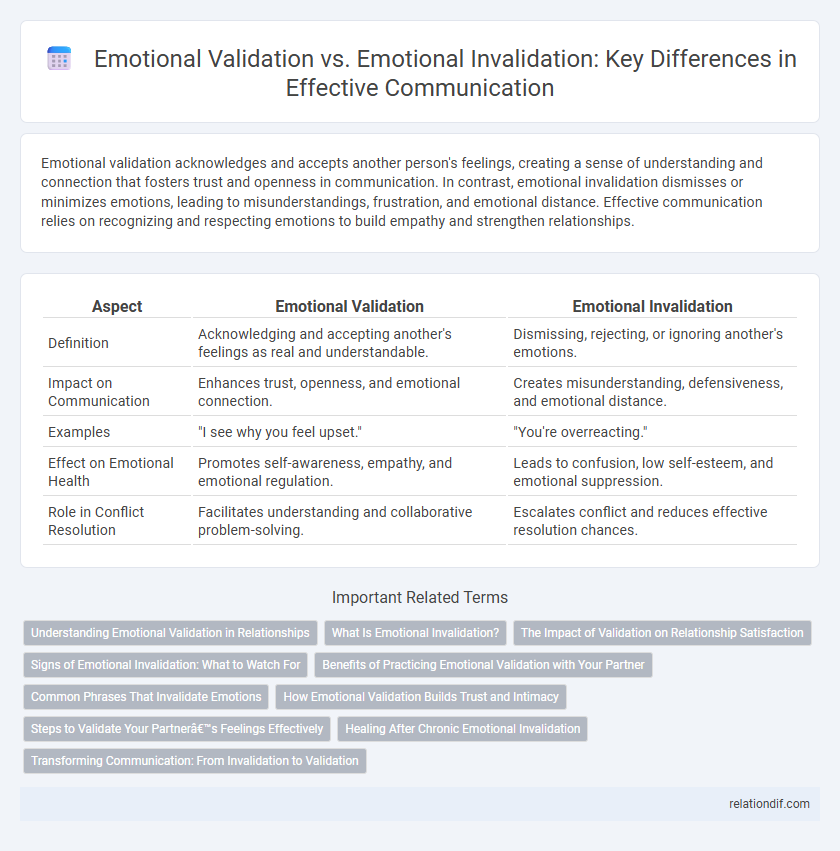Emotional validation acknowledges and accepts another person's feelings, creating a sense of understanding and connection that fosters trust and openness in communication. In contrast, emotional invalidation dismisses or minimizes emotions, leading to misunderstandings, frustration, and emotional distance. Effective communication relies on recognizing and respecting emotions to build empathy and strengthen relationships.
Table of Comparison
| Aspect | Emotional Validation | Emotional Invalidation |
|---|---|---|
| Definition | Acknowledging and accepting another's feelings as real and understandable. | Dismissing, rejecting, or ignoring another's emotions. |
| Impact on Communication | Enhances trust, openness, and emotional connection. | Creates misunderstanding, defensiveness, and emotional distance. |
| Examples | "I see why you feel upset." | "You're overreacting." |
| Effect on Emotional Health | Promotes self-awareness, empathy, and emotional regulation. | Leads to confusion, low self-esteem, and emotional suppression. |
| Role in Conflict Resolution | Facilitates understanding and collaborative problem-solving. | Escalates conflict and reduces effective resolution chances. |
Understanding Emotional Validation in Relationships
Emotional validation in relationships involves recognizing, accepting, and empathizing with a partner's feelings, fostering trust and deepening emotional connection. Contrarily, emotional invalidation dismisses or negates those emotions, often leading to misunderstandings and emotional distance. Prioritizing emotional validation promotes healthier communication, conflict resolution, and mutual respect between partners.
What Is Emotional Invalidation?
Emotional invalidation occurs when a person's feelings are dismissed, ignored, or judged as wrong, leading to increased emotional distress and misunderstanding in communication. It undermines trust and connection by signaling that emotions are unacceptable or inappropriate, which can cause individuals to suppress their true feelings. Recognizing emotional invalidation is crucial for fostering empathy and promoting healthier interpersonal relationships.
The Impact of Validation on Relationship Satisfaction
Emotional validation significantly enhances relationship satisfaction by fostering trust, empathy, and mutual understanding between partners. When individuals feel heard and accepted for their emotions, it reduces conflict and strengthens emotional bonds. Conversely, emotional invalidation leads to misunderstandings, increased relational tension, and decreased overall happiness in partnerships.
Signs of Emotional Invalidation: What to Watch For
Signs of emotional invalidation include dismissing or minimizing feelings, ignoring emotional expressions, and responding with criticism or judgment instead of empathy. This often manifests through phrases like "You're overreacting" or "That's not a big deal," which undermine a person's experience and contribute to emotional distress. Recognizing these signs helps foster healthier communication by validating emotions and promoting understanding.
Benefits of Practicing Emotional Validation with Your Partner
Practicing emotional validation with your partner fosters deeper trust and strengthens your emotional connection by acknowledging and accepting their feelings without judgment. This approach reduces conflict and promotes healthier communication patterns, as both partners feel heard and understood. Consistent emotional validation enhances relationship satisfaction and supports emotional resilience during challenging times.
Common Phrases That Invalidate Emotions
Common phrases that invalidate emotions often dismiss or minimize individual feelings, such as "You're overreacting," "It's not a big deal," or "Just calm down." These expressions undermine emotional experiences and hinder effective communication by creating a sense of misunderstanding or rejection. Recognizing and avoiding invalidating language promotes emotional validation, which strengthens interpersonal connections and trust.
How Emotional Validation Builds Trust and Intimacy
Emotional validation reinforces trust by acknowledging and respecting another person's feelings, creating a safe space for open communication. When individuals feel heard and validated, emotional intimacy deepens, fostering stronger connections and reducing misunderstandings. Consistent emotional validation enhances relational stability by promoting empathy and psychological safety.
Steps to Validate Your Partner’s Feelings Effectively
Recognizing and naming your partner's emotions demonstrates emotional validation, which strengthens trust and connection. Listen actively by maintaining eye contact, nodding, and reflecting back their feelings with phrases like, "It sounds like you're feeling overwhelmed." Avoid dismissive comments or unsolicited advice, focusing instead on empathy and acceptance to foster a supportive communication environment.
Healing After Chronic Emotional Invalidation
Healing after chronic emotional invalidation involves recognizing and validating one's own feelings to rebuild self-trust and emotional resilience. Therapeutic approaches such as cognitive-behavioral therapy and mindfulness help individuals reinterpret negative core beliefs formed through repeated emotional rejection. Establishing supportive relationships that foster consistent emotional validation promotes long-term psychological healing and improved interpersonal communication.
Transforming Communication: From Invalidation to Validation
Transforming communication from emotional invalidation to validation fosters deeper understanding and stronger connections by acknowledging and affirming others' feelings. Emotional validation involves actively listening, empathizing, and expressing acceptance, which reduces defensiveness and builds trust in relationships. Shifting to validation enhances emotional resilience and promotes healthier, more open exchanges in both personal and professional interactions.
Emotional validation vs Emotional invalidation Infographic

 relationdif.com
relationdif.com